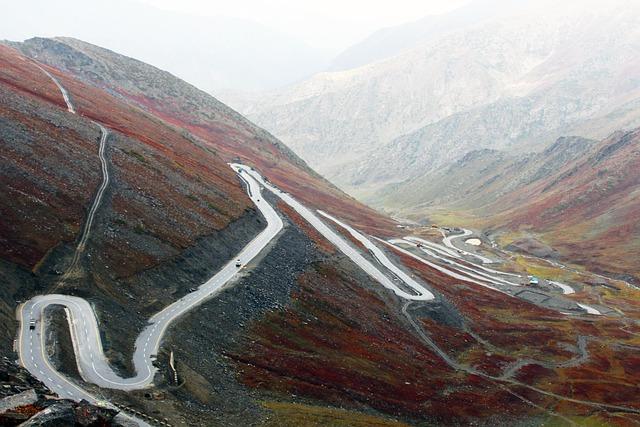In the heart of South Asia, Pakistan stands at a pivotal juncture, grappling with the dual challenges of revitalizing its economy and modernizing its infrastructure. As the nation looks to the future, the call for a comprehensive overhaul of its roads, bridges, energy systems, and urban landscapes has never been more urgent. Revamping Pakistan’s infrastructure is not merely about laying down new concrete; it is an ambitious endeavor that holds the potential to ignite economic growth, foster connectivity, and improve the quality of life for millions. This article delves into the multifaceted role that infrastructure plays in shaping a nation’s development, exploring the strategies, investments, and innovations necessary to transform Pakistan’s physical landscape into a catalyst for progress. Join us on this journey as we uncover a path to a thriving, interconnected, and resilient future for Pakistan.
Transforming Urban Spaces with Sustainable Planning
In the heart of urban development lies the potential to revitalize communities through environmentally conscious designs. By embracing sustainable planning principles, cities can create spaces that not only meet the current needs of their citizens but also preserve resources for future generations. Key strategies for achieving this transformation include:
- Green Infrastructure: Integrating parks, green roofs, and urban forests to improve air quality and enhance biodiversity.
- Public Transportation Enhancement: Expanding and modernizing transit options to reduce reliance on private vehicles and lower carbon footprints.
- Mixed-Use Development: Designing areas that combine residential, commercial, and recreational spaces to foster community interaction and reduce travel needs.
The adoption of these strategies not only improves the physical landscape but also promotes social well-being and economic vitality. A focus on community engagement in planning processes ensures that locals have a voice in creating their environment, leading to better outcomes that resonate with the needs of residents. Consider implementing a framework to assess the effectiveness of urban development initiatives, such as the following:
| Objective | Measurable Outcome | Target Timeline |
|---|---|---|
| Increase Green Spaces | 25% more parks and green areas | 5 years |
| Boost Public Transport Usage | 30% rise in ridership | 3 years |
| Enhance Community Engagement | 50% participation in planning surveys | 1 year |

Revitalizing Transportation Networks for Economic Efficiency
The transformation of Pakistan’s transportation infrastructure is essential for enhancing economic productivity and connectivity. Upgrading roadways, rail networks, and air travel facilities will not only facilitate smoother logistics but will also reduce transit times and costs for businesses across the nation. A revitalized transportation system can lead to increased trade opportunities, urban mobility, and accessibility to remote areas, enabling a more inclusive economic landscape. Key initiatives should include:
- Expansion of rail networks: Linking major cities with efficient and high-speed trains.
- Improvement of highways: Ensuring they are well-maintained and capable of handling higher volumes of cargo and commuters.
- Development of urban transport systems: Incorporating metro systems and public buses to alleviate traffic congestion.
- Investment in aviation infrastructure: Enhancing airport facilities to accommodate growing passenger and cargo demands.
To further illustrate the economic impact of improved transportation, consider the correlation between infrastructure investment and economic growth. Statistical data can reveal how a well-connected nation attracts foreign investments and stimulates local industries. For instance, countries that invested in their transportation frameworks experienced a notable uptick in GDP growth rates. The following table highlights the potential benefits of such investments:
| Infrastructure Investment | Projected Economic Growth (%) | Job Creation (Thousands) |
|---|---|---|
| Highway Development | 3.5 | 150 |
| Railway Modernization | 2.8 | 100 |
| Urban Transit Systems | 4.0 | 200 |
| Aviation Upgrades | 3.0 | 80 |

Empowering Rural Development through Infrastructure Investments
Investing in infrastructure is pivotal for catalyzing sustainable growth in rural Pakistan. Enhanced transport networks, energy supplies, and communication systems not only bolster local economies but also integrate these regions into the national framework. Key initiatives that need to be prioritized include:
- Road Development: Constructing and upgrading rural roads to improve access to markets and services.
- Energy Projects: Implementing renewable energy solutions to provide reliable power to off-grid communities.
- Water Supply Systems: Establishing clean and efficient water systems to promote health and agricultural productivity.
- Digital Infrastructure: Expanding internet connectivity to enhance education and entrepreneurship opportunities.
Moreover, strategic infrastructure projects can spark job creation and attract private investment, creating a virtuous cycle of development. This synergy is essential in uplifting rural livelihoods and ensuring that all citizens benefit from national prosperity. For a clearer understanding of potential changes, consider the following hypothetical impact of infrastructure investment in rural areas:
| Infrastructure Project | Projected Job Creation | Annual Economic Growth (%) |
|---|---|---|
| Road Networks | 50,000+ | 1.5 |
| Renewable Energy | 30,000+ | 2.0 |
| Water Management | 20,000+ | 1.2 |
| Digital Access | 15,000+ | 1.8 |

Harnessing Technology for Smart Infrastructure Solutions
The integration of digital technologies into infrastructure development is revolutionizing the way we build and manage public assets. By leveraging innovative solutions such as IoT (Internet of Things), big data, and artificial intelligence, we can transform traditional infrastructure into smart systems. These technologies facilitate better monitoring and management of infrastructure, leading to enhanced efficiency and sustainability. For instance, smart traffic management systems can significantly reduce congestion, while sensor-enabled bridges can monitor structural health in real-time, ensuring safety and longevity.
Implementing smart infrastructure also presents substantial economic benefits. Enhanced connectivity can stimulate regional growth, while predictive maintenance powered by data analytics minimizes downtime and repair costs. Key elements of a successful smart infrastructure strategy may include:
- Modular construction techniques: Allowing for quicker and more cost-effective builds.
- Integrated urban planning: Ensuring that transportation, energy, and housing developments work in harmony.
- Sustainable materials: Reducing the environmental impact of construction projects.
To visualize the impact of these initiatives, consider the following table showcasing projected outcomes of smart infrastructure investments:
| Investment Area | Projected Benefit |
|---|---|
| Smart Traffic Management | Reduced travel time by up to 30% |
| Predictive Maintenance Systems | Maintenance costs lowered by 20% |
| Renewable Energy Integration | Energy costs reduced by 15% |
In Summary
As we stand at the precipice of transformation, the vision for a revitalized Pakistan emerges not just as a dream, but as an achievable reality. Revamping the nation’s infrastructure serves as the backbone for economic prosperity, social progress, and environmental sustainability. By embracing innovation and collaboration, we can pave the way for a resilient future, one where every road, bridge, and public transit system tells the story of a nation reborn.
Investing in infrastructure is more than constructing buildings or roads; it is about forging connections—between people, regions, and opportunities. The path ahead is undoubtedly complex, woven with challenges that require careful navigation. Yet, with resolve and a collective vision, Pakistan can transform its landscape into a thriving hub of development and growth.
As we conclude this exploration of infrastructure’s potential, let us remember that the foundation we lay today will shape the lives of generations to come. The journey towards revitalization begins with us, and the time for action is now. Embracing this necessary endeavor, together, we can build not just structures, but a future built on unity, progress, and hope.



